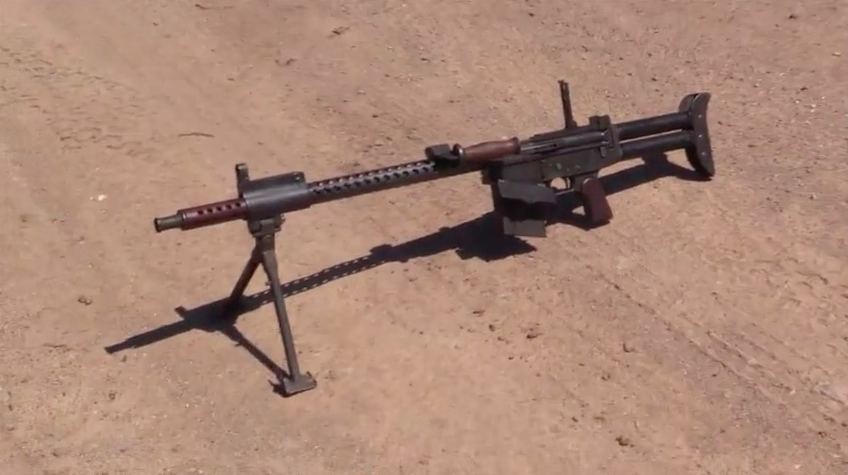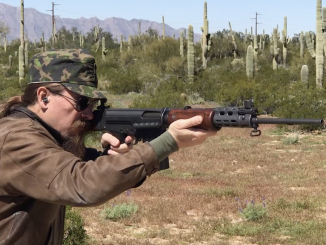The Israeli Uzi has become a truly iconic submachine gun through both its military use and its Hollywood stunts – but how effective is it really?
I found this fully automatic Uzi Model A to be actually rather better than I had expected. Despite the uncomfortable sharp metal stock, the rate of fire and large sights make this a relatively easy gun to shoot. Not one of the absolute best, but certainly above average.




This is a compact weapon, better suited for vehicle stowage (tank crews can’t stuff infantry rifles into their tanks). And it’s much better for commandos in room-to-room engagements…
Used it, overated. Safety was iffy. No wonder it was replaced by the MP5 quickly.
With 3.5 kg (7.7 lbs) empty it is not a light weapon which certainly helps with stability (3.75 times of typical 9mm pistol). In comparison, CZ vz.23 is not much lighter. But if I was to choose it would be UZI; it has much better stock. I was really impressed with it when I first picked it up. Mind you, CZ has some clever features on it too.
What is view of others: is MP5 a better weapon? It sold and still is selling phenomenally.
“What is view of others: is MP5 a better weapon? It sold and still is selling phenomenally.”
According to https://modernfirearms.net/en/submachine-guns/germany-submachine-guns/hk-mp5-eng/
The success of the MP-5 is outstanding. It is based on the high quality and reliability of the gun, great single-shot accuracy (thanks to its closed bolt action), great flexibility and, of cause, good marketing. It seems that no other modern SMG at this time can rival the MP-5 in popularity (UZI is not manufactured anymore).
However:
German Army (Bundeswehr) did not adopted the MP-5, most probably due to the economical reasons, and turned instead to the… UZI submachine guns, made under license in Belgium.
That kind of “sparung”, traditional German national obsession, is in this case out of place. MP5 was purchased by police forces elsewhere across globe and first time I saw it was on airport in Germany.
Actually, if you look how is UZI structured (formed sheet-metal) it is by the same logic like AK rifle. HK MP5 on the other hand is much finer in every aspect (mastery of sheet metal at the utmost) and on top of it can be used in semi-auto. UZI is roughneck’s tool while MP5 is a ‘feinschmecker’.
Ian gives a mini seminar on proper use of a submachine gun. Use the stock, use the sights, fire short bursts. Yay Ian!
Side by side, MP5 is more controllable and accurate due to closed-bolt firing. The retracting stock on the MP is more stable and comfortable than the folding stock on the Uzi; their fixed stocks are about even.
MP5s generally have better triggers than Uzis.
The MP5 sights are better beyond 50 meters, but the Uzi’s are faster to “pick up” at CQB range. An optical sight is more easily fitted to an MP5 than an Uzi.
The MP5’s selection of sound suppressors (the MP5SD, etc.)are generally more effective than those commonly used on Uzis.
On the whole, I consider the Uzi an excellent vehicle crew weapon, especially in desert climates. The MP5 is a better choice for covert ops or CTW, where you often have to shoot just the target and avoid hitting the hostage.
cheers
eon
Appreciate your view Eon. Short of personal experience with either I tend to feel long same line. One time I had something to do with HK rifles and I recall, they are refined even past FAL.
“consider the Uzi an excellent vehicle crew weapon, especially in desert climates. The MP5 is a better choice for covert ops or CTW, where you often have to shoot just the target and avoid hitting the hostage.”
It should not be overlooked that UZI is simply earlier weapon, as it was produced since about 1951 when MP5 was adopted in 1966 (data from Modern Firearms), so it is not surprising that newer weapon is superior.
Ok, after some thinking, 15 years difference, might looks not too big, however it is crucial to also consider situation of Israel in 1951 and Bonn Republic in 1966.
Geopolitical-wise Israel was still new country and it they must take in account possibility of taking part in full-scale conventional (non-nuclear) warfare (see: Operation Kadesh) as well possibility of hostile military units intruding into their territory (see: Pe’ulot HaTagmul), while for Bonn in 1966 most probable war scenario was attack by Soviet Union and soviet-aligned countries from East Germany with usage of all weapons without limitations.
Israel in 1951 was using wide array of various fire-arms from very various sources, see for example https://en.wikipedia.org/wiki/Arms_shipments_from_Czechoslovakia_to_Israel_1947%E2%80%9349
introducing “Israeli own” fire-arm which would replace such variety would simplify training, supply of spare parts and also somewhat boost morale of units using it (we use own weapons, not bargain!)
Summing up: There was little pressure to develop new sub-machine gun or produce it in big numbers in Bonn Republic in 1966 unlike Israel in 1951.
Who was intruding into hostile territory in 1956 after “cross border” raids by refugees from 1948…? Ah, that’s right. The IDF into Gaza and Egypt as I recall. Not the only “cross border” business to speak of either.
Benny Morris (1994). Israel’s Border Wars, 1949-1956: Arab Infiltration, Israeli Retaliation, and the Countdown to the Suez War. Oxford University Press.
Israel’s Border Wars 1949–1956: Arab Infiltration, Israeli Retaliation, and the Countdown to the Suez War, Oxford, Clarendon Press, 1993. ISBN 978-0-19-829262-3
Maybe this is the opportunity to remind of Ian’s earlier show from October of last year:
https://www.forgottenweapons.com/action-arms-semiauto-uzi-carbines-model-a-and-model-b/
As he mentioned in video, there were other designers and builders who picked on idea of semiauto UZI parts for civilian sales; perhaps most known being McKay enterprise. I recall advertising in gun magazines from 80s with enticing question: “are you enth-UZI-astic ?”. I used to joke about it quite a bit.
Used the Uzi a little, carried and used both the MP5 and the Colt SMG a good bit (civilian law enforcement). Found the Uzi lacking and the MP5 very overrated. Nothing beats the MP5 for “tacti-cool” points, but I preferred the Colt SMG – same manual of arms as our rifles, nothing new to learn, and being a closed-bolt design it was just as accurate as the MP5.
I guess the reason the Colt SMG is okay is that one doesn’t have to retrain in order to master the thing if one has already mastered the AR-15.
Absolutely correct, sir.
Not many closed-bolt SMGs in 1951. (I’m sure other readers will be able to list early ones off the top of their heads, but I can’t)
If the MP5 doesn’t have heat problems, there’d be an unavoidable gain in handling and aiming. Well, even if it DOES have heat problems that would be true.
“Not many closed-bolt SMGs in 1951.”
There was Italian FNA-B 43 which was produced in 1943-1944
https://modernfirearms.net/en/submachine-guns/italy-submachine-guns/fna-b-43-eng/
it was delayed blow-back and fired from closed bolt
During the German military trials, the Swedish Carl Gustav came out best. This is reported by personnel involved in the trials. The decision in favour of the Uzi came directly from Secretary of Defence Fran Josef Strauss, which is documented.
Do not take this as a criticism of the UZI. I carried it and shot a lot it during my military service and consider it a most reliable, compact weapon. I like the MP2 (Bundeswehr designation) very much.
The MP5 fullfills a totally different role, because it allows police users to place a well aimed, precise single shot. That is the reason for its success. Bundeswehr never used it except the extremely compact version MP5K in military police units involved in personal protection duties. Probably special forces use its integral-silencer version, also not in the traditional submachine gun role.
A friend of mine who was in the french special forces(13 ieme shock)
in Algeria about 1962 used a silenced uzi. It was all about deniability as they were not in uniform
You are holding it on the left side, but for the right hand shooters,
does that sling attachment point right on the folding stock bump on your cheek, making it uber-uncomfortable ?